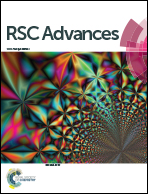Enhanced p-nitrophenol removal in a membrane-free bio-contact coupled bioelectrochemical system†
Abstract
In this study, a membrane-free bio-contact coupled bioelectrochemical system (BC-BES) was established for the enhanced reductive transformation of p-nitrophenol (PNP). The results showed that the electric field played a key role in both PNP reduction and p-aminophenol (PAP) formation. The vast majority of PNP was reductively transformed to PAP in the biocathode of BC-BES. At a cathode potential of −1000 mV vs. Ag/AgCl and hydraulic retention time (HRT) of 8.9 h, PNP removal rate as high as 18.95 ± 0.10 mol per m3 per day could be achieved in the BC-BES with acetate as the electron donor. High PNP removal and PAP formation could be achieved at low acetate dosage, high initial PNP concentration and short HRT, indicating the strong ability of the BC-BES to resist shock loading. Furthermore, partial mineralization of PAP was observed in the anode of the BC-BES, which was beneficial for the further polishing of the BC-BES effluent. Considering the advantages of high loading rate, low acetate consumption and high system stability, it is hoped that the application of this BC-BES will enhance the reductive removal of nitrophenols from wastewaters.


 Please wait while we load your content...
Please wait while we load your content...